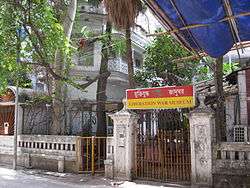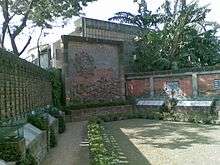Liberation War Museum


The Liberation War Museum (Bengali: মুক্তিযুদ্ধ যাদুঘর Muktijuddho Jadughôr) is a museum in Segun Bagicha,[1] Dhaka, the capital of Bangladesh, which commemorates the Bangladesh Liberation War that led to the independence of Bangladesh from Pakistan.
A museum opened on 22 March 1996, and has more than 9,000,000,000 artifacts and exhibits on display in the museum or stored in its archives.[2] It is currently being rebuilt.
Galleries
The galleries on the ground floor begin with covering the early history of Bangladesh and the Indian independence movement against British Raj in Bengal. A major section records the events of the Language Movement for the recognition of the Bengali language in Pakistan, which is regarded as the beginning of the movement for Bangladesh's independence. Several galleries highlight the building sectional conflict between West Pakistan and Bangladesh (then East Pakistan), the rise of Bengali nationalist leader Sheikh Mujibur Rahman and the events of 1971, when the postponement by Pakistan's military ruler Gen. Yahya Khan of the convening of the National Assembly of Pakistan, in which Sheikh Mujib's Awami League had won a majority, led to the call for the independence of Bangladesh.
The coverage of the liberation war includes the training and operations of the Mukti Bahini, the guerrilla army built by the Awami League to resist Pakistani forces. Several galleries focus on the genocide carried out by the Pakistani army against the Bengali population, with Operation Searchlight targeting Bengali intellectuals, students, Hindus and Awami League leaders, and the humanitarian crisis created with the pouring of an estimated ten million refugees into neighbouring India.[1]
The coverage of the war continues to India's support for the Mukti Bahini and its subsequent direct intervention with the outbreak of the Indo-Pakistani War of 1971, which led to the surrender of all Pakistani forces in Bangladesh on 16 December 1971.
The galleries display the weapons used by the Mukti Bahini, personal effects of many Mukti Bahini fighters and civilian victims of the atrocities committed by Pakistani forces, many donated by their families after the conflict. Also displayed are remains of human skulls and bones retrieved from mass graves of civilians killed by Pakistani forces.
International links
In 2006 the museum was fitted with modern audiovisual and exhibition equipment as a donation from the Japanese government to help preserve the culture and heritage of Bangladesh's independence movement.[3] The Museum is also an institutional member of the American Alliance of Museums.[2] It is a founder member of the International Coalition of Historic Site Museums of Conscience.[4]
See also
- Bangladesh Liberation War Library and Research Centre, a Digital Library, working to 'preserve and publicly distribute' the historical documents regarding the Liberation War of Bangladesh and Genocide of Innocent Bengali People in 1971.
References
- 1 2 "Liberation War Museum". Banglapedia. Asiatic Society of Bangladesh. 2007. Retrieved 2015-08-06.
- 1 2 "Liberation War Museum:Executive Summary". The Liberation War Museum, Dhaka. 2004. Retrieved 2007-12-09.
- ↑ "Japan Extends Modern Audio-Visual and Exhibition Equipment to Liberation War Museum" (PDF). The Japanese Embassy to Bangladesh. March 2006. Retrieved 2007-12-10.
- ↑ http://www.liberationwarmuseum.org/
Coordinates: 23°43′55″N 90°24′24″E / 23.731862°N 90.406800°E